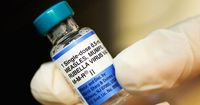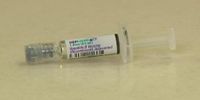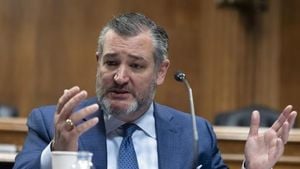At the headquarters of the Centers for Disease Control and Prevention in Atlanta on September 18, 2025, a crucial advisory panel voted to limit the use of a combined vaccine for measles, mumps, rubella, and varicella (MMRV) in young children—a decision that has sent ripples through the medical community and reignited debate over the future of childhood immunization in the United States.
The Advisory Committee on Immunization Practices (ACIP), newly appointed by Health Secretary Robert F. Kennedy Jr., voted 8-3 with one abstention to recommend against giving the MMRV vaccine to children under the age of 4, citing concerns about a heightened risk of seizures in this age group. Instead, the panel advised that children receive separate shots for the MMR trio and for varicella, the virus responsible for chickenpox. Although many pediatricians already prefer administering these vaccines separately, the combined shot has remained an option for parents hoping to minimize the number of injections their children receive in a single visit.
The implications of this recommendation are far-reaching. According to Axios, the panel’s move could mean that health insurers will soon stop covering the MMRV vaccine for children under four. However, in a separate vote, the committee ensured that the federal Vaccine for Children’s Program would continue to provide coverage for the combined shot, at least for now.
ACIP’s decision comes at a time when childhood immunization rates are already in a worrying decline. NBC News, in collaboration with Stanford University, recently completed a sweeping data investigation showing that since 2019, 77% of U.S. counties and jurisdictions have seen drops in childhood vaccination rates, with some areas reporting decreases of over 40 percentage points. The same analysis revealed that 67% of counties now fall below the 95% threshold for MMR vaccination coverage—considered the minimum for herd immunity against measles. The consequences are not hypothetical: a 2025 measles outbreak in West Texas, where vaccination rates had slipped to 77%, resulted in three deaths, including two young girls.
In places like St. Louis, Missouri, the decline is particularly stark. The percentage of kindergartners starting school with all required vaccines has plummeted from 91.6% in the 2010-2011 school year to just 75.9% in 2024-2025, according to the NBC News investigation. MMR coverage among kindergartners in St. Louis now stands at 74%, even lower than the Texas county at the heart of the recent measles outbreak. The reasons for these declines are complex: rising exemption rates, difficulties accessing healthcare, anti-vaccine messaging on social media, and, increasingly, skepticism fueled by federal government actions.
During the Atlanta meeting, the ACIP also debated another contentious issue: whether to restrict the Hepatitis B vaccine at birth to newborns whose mothers test positive for the virus, delaying the shot for others until at least one month old. The panel postponed a vote on this recommendation until Friday, but the discussion was heated. The CDC has long recommended the Hepatitis B vaccine at birth to protect infants from both perinatal and environmental exposure, which can lead to lifelong complications or even death. CDC staff warned that delaying the vaccine could create dangerous gaps in coverage, particularly as 12% to 16% of U.S. pregnant women go unscreened for Hepatitis B. The risks associated with the birth dose, they emphasized, are generally small and mild.
Yet, Kennedy and several panel members questioned the necessity of universal vaccination at birth. As reported by AZFamily, experts like Anu Hosangadi of the Hepatitis B Foundation cautioned that removing the birth dose could increase the risk of infection, especially since many adults are unaware of their Hepatitis B status. "If 50% of adults that present for delivery or 50% of our adults in the population don’t know their hepatitis B status as far as illness, and we continue to have children with congenital hepatitis B infections, and we remove the birth dose, we increase the risk to our population," Hosangadi explained.
Medical organizations were quick to respond to the ACIP’s actions and the tone of the meeting. Representatives from groups such as the American College of Physicians and the Society for Adolescent Health and Medicine voiced serious concerns that the panel was acting without sufficient data and failing to consider the real-world impact on health equity. Amy Middleman, representing the Society for Adolescent Health and Medicine, pressed the panel: "What problem exists in the current schedule that has prompted this entire discussion? We all know, I think, there are always some risks and benefits and we vet those risks and benefits and compare them. We have an immunization schedule for Hepatitis B that's been incredibly successful ... I'm trying to figure out what the question was that really prompted this?"
Others warned that the proceedings themselves could fuel vaccine hesitancy and misinformation. Sean O’Leary, chair of the American Academy of Pediatrics’ committee on infectious diseases, lamented, "The primary goal of this meeting was to sow distrust and instill fear among parents and families. It’s one thing to ... talk with parents and say, be careful of your sources of information. Be careful what you see on social media, those types of things. In this case, they're hearing it from their federal government, and it’s just heartbreaking."
Panel chair Martin Kulldorff pushed back against accusations of being anti-vaccine. Addressing the group, he declared, "You have falsely been called antivaxxers, but your stance is not only pro-children, but also pro-science, pro-public health, and pro-vaccines." Kulldorff also noted criticism from nine former CDC directors, who recently argued in The New York Times that Americans should be wary of the panel’s composition unless its members were willing to engage in open debate. In response, Kulldorff announced plans to establish working groups to further investigate vaccines administered during pregnancy and to review other childhood immunizations.
For communities already grappling with falling vaccination rates, the ACIP’s recommendations could have immediate, practical consequences. In Arizona, state law governing which vaccines pharmacists can administer relies on ACIP guidance, which has led to confusion over COVID-19 shots and prompted Governor Katie Hobbs to issue an executive order to expand access. Local experts worry that changes to federal recommendations could further undermine insurance coverage and reduce access, especially for vulnerable populations. "This committee must preserve access to vaccines to protect people in our country," urged Dr. Julie Stone during the ACIP hearing.
Behind the statistics are real families navigating a shifting landscape. In St. Louis, school nurses like Virginia Wilson are working overtime to bring students up to date on their immunizations, often facing barriers like transportation, lack of paid leave, and mistrust of the healthcare system. As Wilson put it, "Maybe they don’t have the funds or cannot get there, can’t get off of work. We can maybe work with a local clinic that can come and do a clinic here at our school. Or they can go to a community clinic, and we can make sure that they get there."
While some parents, like Kimberly Jones, have grown skeptical of vaccines after personal experiences, others, such as Emily and Ryan Pratt, are alarmed by the risks to vulnerable children—like their daughter Lucy, who has a rare autoimmune disease and depends on community immunity for protection. "Lucy could potentially die from one of these diseases because people were unwilling to vaccinate and create a community where those who are at high risk could be protected," Emily Pratt told NBC News.
With the CDC still needing to approve the ACIP’s recommendations—and with debates over vaccine policy growing ever more politicized—the future of childhood immunization in America hangs in the balance. The coming months will test whether public health can withstand the pressures of politics, misinformation, and changing parental attitudes, or whether preventable diseases will once again gain a deadly foothold.





